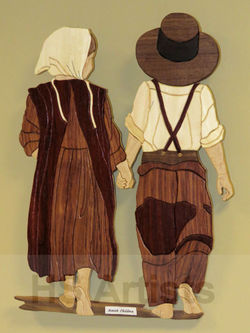
Ron Genter
Turning wood into art
Unusual hobby yields unique wooden creations
Sara Martin - Erickson Living Tribune
January 11th, 2017
Ron Genter is accustomed to confused looks when he mentions that one of his hobbies is intarsia.
“It’s not something people have necessarily seen or heard of,” says Ron, a retired geophysicist. “Webster’s Dictionary defines intarsia as a mosaic, usually of wood, fitted into a support.”
Ron’s handiwork—intricate images hewn from varying shades of wood—leaves no doubt that he’s both a woodworker and an artist.
“Intarsia can also refer to stained glass or knitting,” says Ron. “It’s the process of putting different colors together to form an image. My medium happens to be wood.”
Acquiring tools along the way
Ron’s interest in “puttering,” as he puts it, stems from his childhood on a farm, where he tinkered with tools.
His career, however, didn’t afford him enough time in any one location to establish a woodshop until Ron and his wife Jan moved to Midland, Tex.
“Jan and I moved 16 times during our marriage,” says Ron. “I acquired tools over the years and had all the makings of a good woodshop by the time we arrived in Midland. I set up shop in the third bay of our garage.”
Initially, Ron crafted furniture pieces for the house—cabinets and television stands. He subscribed to Wood Magazine, which frequently included patterns for intarsia projects.
“I decided to try one,” says Ron, whose early efforts include a duck floating on water and a pair of praying hands. “I kept making them and giving them away to family and friends.”
Detailed process
Ron’s process remains consistent today. First, he chooses a plan from the Internet or a catalog. Next, he selects wood for the project.
“This is an important step because there’s no painting involved,” says Ron. “It’s just the various shades of wood that come through.”
Ron finds some pieces of wood, like oak, at Lowe’s and Home Depot. Other, more exotic, woods he orders by mail.
“Once I have all my wood, I cut out the pieces according to the pattern,” Ron says. “Simpler patterns may have 20-something pieces of wood. More complex designs can have up to 70 pieces of wood.”
When he has all the pieces cut, Ron sands the edges and fits them together like a jigsaw puzzle. Then he glues the pieces onto the backing, typically one large piece of wood that forms the background of the design.
“The last step is to cover the whole project with a clear coat of polyurethane,” says Ron. “Sometimes I’ll use a glossy coat, sometimes a satin coat, and sometimes a combination of the two, depending on the effect I want to create.”
Fully appointed woodshop
In July 2015, after 25 years in Midland, Ron and Jan moved to Highland Springs, the Erickson Living community in North Dallas.
“Our son and his family live in Dallas, and we wanted to be near our grandchildren,” says Ron. “We’d known of Highland Springs for years and liked the amenities and relaxed atmosphere.”
Chief among those amenities is a fully appointed woodshop with all the tools Ron needs to continue his hobby.
“The tools I use most are a band saw, a scroll saw, and a Dremel,” says Ron. “The woodshop at Highland Springs has everything I need and much more. There’s even a computer-controlled router in the woodshop.”
Other woodworkers at Highland Springs, intrigued by Ron’s handiwork, invited him to speak at the community’s bimonthly men’s breakfast.
“I was surprised by the number of questions they asked,” says Ron. “One resident said he wanted to give intarsia a try. He’s working on his own project now.”
 Life's Journey |
|---|
 Visla |
 Amish ChildrenIntarsia - wood mosaic |
 Batter upIntarsia - wood mosaic |
 Gone FishinIntarsia - wood mosaic |
 Hole-in-oneIntarsia - wood mosaic |
 The Big OneWood - Trout after a lure |
 Praying HandsWood |
 My TractorWood Cartoon character on tractor |
 My ShopWood - Clock over shop tools |
 DukeWood - Face of Golden Lab |
